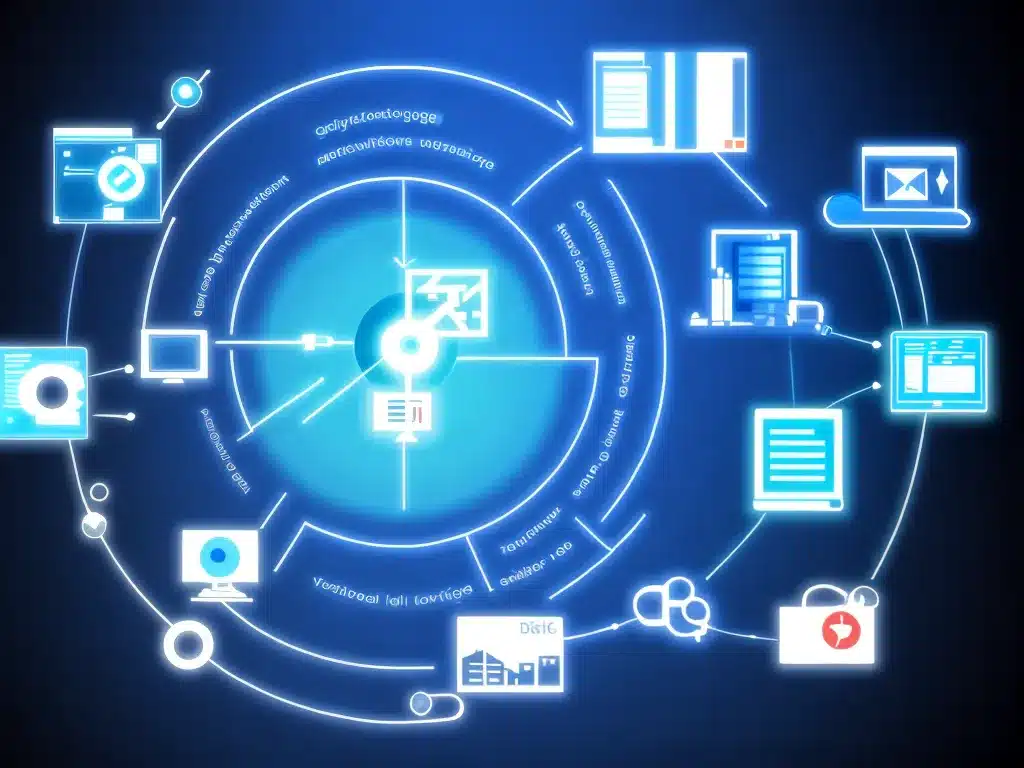Data Lifecycle Challenges with IoT Devices
Introduction
The Internet of Things (IoT) refers to the connection of devices and sensors to the internet and to each other. These connected devices generate massive amounts of data, bringing new challenges in managing the data lifecycle. The data lifecycle includes the flow of data from creation to disposal and covers aspects like data collection, storage, processing, analysis, and archival.
Managing the data lifecycle for IoT can be complex due to the scale, diversity, and distribution of devices and the data streams they produce. This article examines the key challenges with the IoT data lifecycle and strategies to address them.
Data Collection
The first step in the IoT data lifecycle is data collection. This involves gathering data from a variety of sensors, devices, and systems.
Scale and Frequency
A major challenge is the massive scale and high velocity of data generated. An IoT ecosystem may have millions of devices producing data continuously, from temperature readings to equipment logs. This flood of real-time data makes collection, transmission, and storage difficult.
Strategies like edge computing can help by processing data locally on devices before transmitting only required info. Data reduction techniques like summarization and compression also optimize collection.
Diversity
Another hurdle is the diversity of data types and formats from different devices and systems. Structured, unstructured, binary, and textual data may flow from disparate sources.
Using standardized schemas like JSON can help tackle diversity during collection. Middleware can also translate between different protocols and data formats.
Distribution
Since IoT devices are geographically distributed, collecting data across locations is hard. Weak connectivity in rural or remote areas can lead to data gaps.
Mesh networks and store-and-forward techniques help gather data with unstable connections. Fog nodes also aggregate data locally before sending to the cloud.
Data Storage
After collection, the flood of IoT data needs to be stored and managed efficiently.
Scale
The terabytes of data arriving from IoT devices makes storage and database scalability a major hurdle. Data volumes can easily outgrow storage capacity.
Using scalable cloud storage like Amazon S3 allows expanding capacity on demand. Big data databases like Cassandra also horizontally scale to handle large volumes.
Security
With sensitive IoT data, there is a constant risk of unauthorized access and cyber attacks during storage. Data encryption and access control are essential.
Encrypting data at rest and in transit using standards like SSL/TLS improves security. Granular access policies, multi-factor authentication, and network segmentation also help.
Cost
Storing the rapid influx of IoT data cost-effectively is challenging. Storage for rarely accessed historical data can become expensive.
Using tiered storage with options like Glacier to archive colder data reduces cost. Data compression and deduplication also optimize storage needs.
Data Processing and Analysis
To extract value from IoT data, we need to process and analyze it efficiently.
Velocity
The speed of incoming IoT data makes real-time processing difficult. Analysis at intervals like every 15 minutes is not enough.
Stream processing frameworks like Kafka and Flink allow continuous analysis of data streams. In-memory processing also delivers faster analysis.
Variety
The many data types, formats, and semantics make analysis challenging. Data needs normalization before running analytics.
Using an ontology models the entities and relationships in the data. An ontology enables standardizing varied IoT data.
Veracity
With so many devices, noise and errors get introduced during collection. Cleaning this dirty data is an extra step.
Data validation on device sensors spots anomalies early. Filters and smoothing algorithms also clean noisy signals and outliers.
Data Archival
Finally, the massive amounts of processed IoT data needs to be archived cost-effectively.
Data Lifespan
Some IoT data like fault logs may need to be stored for over a decade due to regulatory requirements. Managing data for its full lifespan is difficult.
Having an archive policy that moves older data to cheaper storage tiers reduces cost. Setting retention schedules avoids keeping data forever.
Deletion and Destruction
Securely deleting IoT data at end of life is important for maintaining privacy. But truly destroying petabytes of data is challenging.
Using encryption ensures deleted data cannot be recovered. Secure data erasure techniques also permanently destroy archived data.
Legacy Systems
Integrating current systems with older legacy systems makes archiving historical data difficult. There are gaps when migrating archives.
Normalization and conversion modules help ingest legacy data into modern databases. Maintaining a unified data catalog also aids in tracking archives.
Conclusion
In summary, IoT introduces data lifecycle challenges in collection, storage, processing, and archival due to the unique scale, speed, variety, and distribution of device data. A robust data management strategy is key to harness the full potential of IoT while overcoming these hurdles. Using technologies like edge computing, stream processing, encryption, and data catalogs can help build an effective IoT data lifecycle. With strong solutions, organizations can turn their connected device data into real-time insights.













